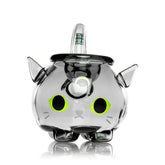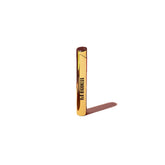-
-
-
Vendor:Zippo
Zippo Classic Lighter | Brushed Chrome
Zippo's Classic Brushed Chrome Lighter is suitable for gift giving in its environmentally friendly gift box and comes with a lifetime guarantee. For optimum performance, fill with Zippo Premium Lighter Fluid. Made in USA. HIGHLIGHTS Classic Zippo lighter shape Brushed chrome finish Lifetime manufacturer's...- $19.99
- $19.99
- Unit price
- per
-
Vendor:SoloPipe
SoloPipe Pipe w/ Built-in Lighter & Glass Bowl - Luxuriant Gunmetal
SoloPipe Pipe w/ Built-in Lighter & Glass Bowl Built for seamless on-the-go action, the SoloPipe Pipe w/ Built-in Lighter is designed to provide a smooth smoking experience in a compact package. Measures just 3.75 inches (9.525cm) long for convenient portability Metal hand pipe with...- $39.99
- $39.99
- Unit price
- per
- Provincial Rose Gold
- Luxuriant Gunmetal
-
Vendor:Pulsar
Zippo Lighter - Pulsar Wolf & Stars - Black Ice
HIGHLIGHTS Classic Zippo lighter Black Ice finish Pulsar Wolf & Stars design Lifetime manufacturer's warranty Made in the USA Note: For USA sales only Order 15 or more Zippos to get a free display- $33.99
- $33.99
- Unit price
- per
-
Vendor:Zippo
Zippo Lighter | Weed Bum | Black Matte
This Classic Zippo Lighter has a black matte finish and adorned with a Weed Bum design. Made in the USA with a metal construction and a windproof design that works virtually anywhere. Backed by Zippo's famous Lifetime Guarantee "it works or we fix it free". HIGHLIGHTS Classic...- $29.99
- $29.99
- Unit price
- per
-
Vendor:Myster
SABR Torch
The SABR lighter is a great on-the-go torch with a convenient shovel for flower or powdery concentrates. The torch lasts for many sessions and heats up quartz surprisingly fast. Features: Quad Outtakes Poker for packing Swivel Shovel On/of knob Fuel Level Window Adjustable Flame...- $29.99
- $29.99
- Unit price
- per
-
Vendor:Zippo
Zippo Multi-Purpose Torch Lighter | 8.5"
Highlights 8.5 inches tall Multi-purpose torch lighter Single, adjustable flame Refillable butane fuel Child-resistant operation Large fuel tank Self-storing interchangeable tips- $77.99
- $77.99
- Unit price
- per
-
Vendor:Special Blue
Special Blue Diablo Butane Torch - Diablo Gold
The Diablo Butane Torch from Special Blue packs double the punch with an adjustable dual flame. Other features include automatic piezo ignition, ergonomic design, easy to refill and has a built-in stand. Torches are sold empty. Butane sold separately. Available in multiple color options. HIGHLIGHTS 6" torch lighter Adjustable...- From $28.99
- From $28.99
- Unit price
- per
- Diablo Black
- Diablo Gold
- Diablo Silver
-
Vendor:Her Highness NYC
The De-Lighter
Need a light? You deserve better than gas station sameness. Level up with our chic, slim, gold-plated De-Lighter and have a light for a lifetime. Lipstick-like in shape, Her Highness' signature gold lighter strikes with a seamless thumb tab (ditch the Bic wheel burn...- $9.99
- $9.99
- Unit price
- per
-
Vendor:Special Blue
Special Blue Inferno Butane Torch - 6.25" - Blue
Highlights 6.25" stand lighter 2-year warranty Refillable butane torch Auto ignition Adjustable flame- $27.99
- $27.99
- Unit price
- per
- Blue
- Red
- Silver
- Black
-
Vendor:Special Blue
Special Blue Sean Dietrich Fury Torch Lighter - 5.5"
5.5 inches tall Refillable butane torch lighter Auto ignition Adjustable flame Sean Dietrich Caterpillar design- $37.99
- $37.99
- Unit price
- per
-
Vendor:Zico
Zico Torch - Blue
Zico Torch Introducing the Zico Torch, a versatile and reliable tool for all your lighting needs. Whether you're camping, cooking, welding, or simply in need of a powerful flame, this torch has got you covered. With its ergonomic design and easy ignition, the Zico...- $29.99
- $29.99
- Unit price
- per
- Blue
- Default Title
-
Vendor:Pulsar
Pulsar Zippo Lighter | Melting Shrooms | Multicolor
This Classic Zippo Lighter has a shiny multi-color finish and adorned with a Pulsar melting psychedelic mushroom design. Made in the USA with a metal construction and a windproof design that works virtually anywhere. Backed by Zippos world famous Lifetime Guarantee "it works or we fix it...- $37.99
- $37.99
- Unit price
- per
-
Vendor:Pulsar
Pulsar Zippo Lighter | Pineapple Women | Brushed Brass
This Classic Zippo Lighter has a brushed brass finish and features a beach lady showing off her lovely pineapples. Made in the USA with a metal construction and a windproof design that works virtually anywhere. Backed by Zippos world famous Lifetime Guarantee "it works or we fix...- $32.99
- $32.99
- Unit price
- per
-
Vendor:Zippo
Zippo Classic Lighter | Black Matte
From timeless design to the unmistakable "click"... from the quality of materials and workmanship to the Lifetime Guarantee... these are the features that make a Zippo Lighter so satisfying to own. Packaged in an environmentally friendly gift box. Fill with Zippo premium lighter fluid....- $23.99
- $23.99
- Unit price
- per
-
Vendor:Zippo
Zippo Butane Lighter Insert | Single Torch | Empty
The single-flame butane lighter insert perfectly fits all classic Zippo lighters. Provides a single adjustable bright blue flame at the push of a button. The insert is rugged, durable and built to last. Retains the famous Zippo "click sound". Covered by a 2-year manufacturers...- $17.99
- $17.99
- Unit price
- per
-
Vendor:RiO
RiO Replacement Torch (Makeover or Matte) by Stache - Purple
RiO Replacement Torch (Makeover or Matte) by Stache The RiO Replacement Torch by Stache is a versatile and reliable torch that fits any batch B+ RiO. With a non-adjustable overflow valve and heat shield, this torch ensures safety and efficiency. Key features: Compatible with...- $44.99
- $44.99
- Unit price
- per
- Purple
- Black
- Teal
- Red
-
Vendor:Zippo
Zippo Classic Lighter | Spectrum
From timeless design to the unmistakable "click"... from the quality of materials and workmanship to the Lifetime Guarantee... these are the features that make a Zippo Lighter so satisfying to own. Packaged in an environmentally friendly gift box. Fill with Zippo premium lighter fluid....- $30.99
- $30.99
- Unit price
- per
-
Vendor:Pulsar
Zippo Lighter - Pulsar Sacred Cat Geometry - Spectrum
HIGHLIGHTS Classic Zippo lighter Spectrum finish Pulsar Sacred Cat Geometry design Lifetime manufacturer's warranty Made in the USA Note: For USA sales only Order 15 or more Zippos to get a free display- $38.99
- $38.99
- Unit price
- per
SIGN UP FOR OUR NEWSLETTER
Receive our latest updates about our products & promotions.

































